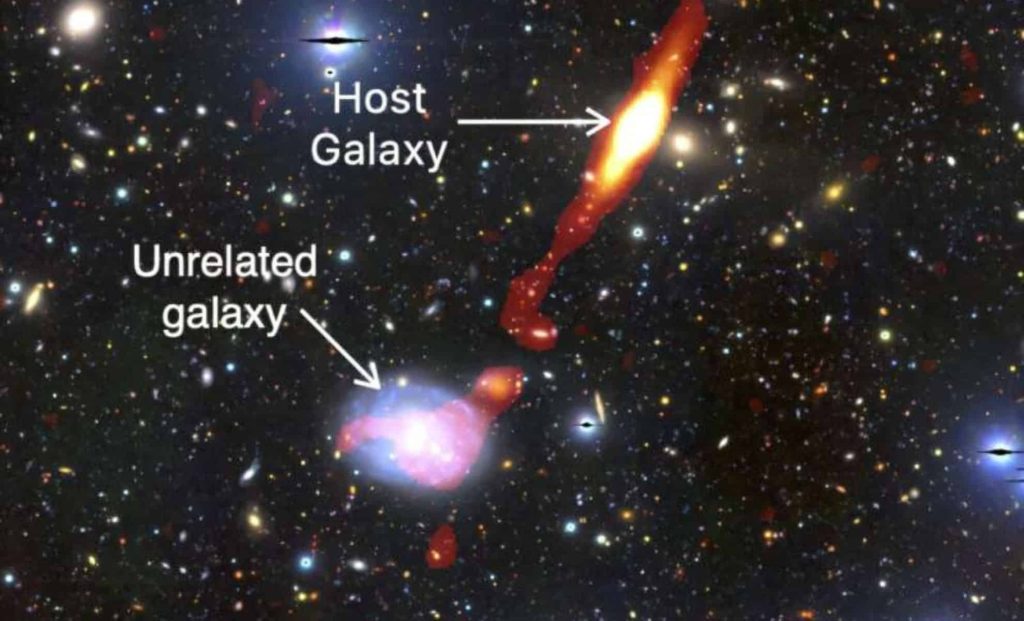Astronomers Uncover Colossal Radio Galaxy 32 Times the Size of the Milky Way – The Daily Galaxy –Great Discoveries Channel

Astronomers have discovered a “troublesome” radio galaxy named Inkathazo, 32 times the size of the Milky Way. Located in a dense galaxy cluster, this colossal structure challenges existing theories about how giant radio galaxies form and evolve. What makes Inkathazo’s plasma jets so unique, and what secrets do they hold about the universe?Astronomers have identified a colossal giant radio galaxy (GRG) stretching 3.3 million light-years across—32 times the size of our Milky Way. Named Inkathazo, which means “trouble” in isiZulu and isiXhosa, this GRG was discovered using South Africa’s MeerKAT telescope. The galaxy’s plasma jets, powered by a supermassive black hole, have perplexed researchers due to their unusual bent shape and extraordinary size, defying expectations for objects located within dense galaxy clusters.The discovery, published in Monthly Notices of the Royal Astronomical Society, challenges existing models of GRG formation and evolution. Scientists are now studying Inkathazo to better understand the complex plasma physics behind these enigmatic cosmic structures.Over the past five years, the number of GRG discoveries has surged, thanks to next-generation radio telescopes like MeerKAT. These telescopes possess unprecedented sensitivity and resolution, enabling astronomers to detect faint radio emissions from GRGs with remarkable precision. “The number of GRG discoveries has absolutely exploded in the past five years thanks to powerful new telescopes like MeerKAT,” said Kathleen Charlton, a Master’s student at the University of Cape Town and the lead author of the study.This rapid expansion in discoveries has transformed GRG research into a dynamic and fast-paced field. “Research into GRGs is developing so rapidly that it’s becoming hard to keep up. It’s incredibly exciting,” Charlton added. The discovery of Inkathazo exemplifies this trend, showcasing the potential of modern technology to uncover the universe’s hidden giants.The galaxy’s nickname, Inkathazo, reflects the challenges it presents to astronomers. “We nicknamed this giant galaxy ‘Inkathazo,’ meaning ‘trouble’ in isiZulu and isiXhosa because it has been a bit troublesome to understand the physics behind what’s going on here,” Charlton explained.One of the most perplexing aspects of Inkathazo is its plasma jets, which do not follow the typical patterns seen in other GRGs. “It doesn’t have the same characteristics as many other giant radio galaxies,” Charlton noted. “For example, the plasma jets have an unusual shape: rather than extending straight across from end to end, one of the jets is bent.”Adding to the mystery is the galaxy’s location. Unlike most GRGs, which are found in relatively isolated regions of space, Inkathazo exists within a dense galaxy cluster. This environment should theoretically limit the growth of its plasma jets due to interactions with surrounding hot gas. “Finding a GRG in a cluster environment raises questions about the role of environmental interactions in the formation and evolution of these giant galaxies,” said Dr. Kshitij Thorat, a co-author of the study from the University of Pretoria.To unravel the mysteries of Inkathazo, researchers used MeerKAT’s exceptional capabilities to create high-resolution spectral age maps. These maps track the age and energy distribution of the galaxy’s plasma, providing critical insights into its evolution.“This discovery has given us a unique opportunity to study GRG physics in extraordinary detail,” said Thorat. The spectral maps revealed regions where electrons in the plasma jets appeared to gain unexpected boosts of energy, likely from interactions with hot gas in the intergalactic medium.“These findings challenge existing models and suggest that we don’t yet understand much of the complicated plasma physics at play in these extreme galaxies,” Thorat added. Inkathazo’s jets serve as a cosmic laboratory for studying the interactions between massive galaxies and their environments, pushing the boundaries of current astrophysical theories.The discovery of Inkathazo is part of a broader exploration of the southern sky, which remains relatively uncharted for GRGs. The galaxy is one of three GRGs identified in a small patch of sky known as COSMOS, an area about the size of five full moons.“The fact that we unveiled three GRGs by pointing MeerKAT at a single patch of sky goes to show that there is likely a huge treasure trove of undiscovered GRGs in the southern sky,” said Dr. Jacinta Delhaize, a researcher at the University of Cape Town, who led the 2021 publication that identified the other two GRGs in COSMOS.MeerKAT’s location and capabilities make it uniquely suited for exploring these hidden giants. “MeerKAT is incredibly powerful and in a perfect location, so is excellently poised to uncover and learn more about them,” Delhaize emphasized.The discovery of Inkathazo represents a significant milestone in radio astronomy, but it is just the beginning. As a precursor to the highly anticipated Square Kilometer Array (SKA), MeerKAT is paving the way for even more profound discoveries.“We’re entering an exciting era of radio astronomy,” said Delhaize. “While MeerKAT has taken us further than ever before, the SKA will allow us to push these boundaries even further and hopefully solve some of the mysteries surrounding enigmatic objects like giant radio galaxies.”Future research with the SKA will focus on:The insights gained from Inkathazo and other GRGs will not only deepen our understanding of cosmic evolution but also illuminate the processes shaping the universe’s largest structures.Got a reaction? Share your thoughts in the commentsEnjoyed this article? Subscribe to our free newsletter for engaging stories, exclusive content, and the latest news.Comment Save my name, email, and website in this browser for the next time I comment.
© 2024 | Daily Galaxy | All rights reserved
Source: https://dailygalaxy.com/2025/01/radio-galaxy-32-times-size-milky-way/






